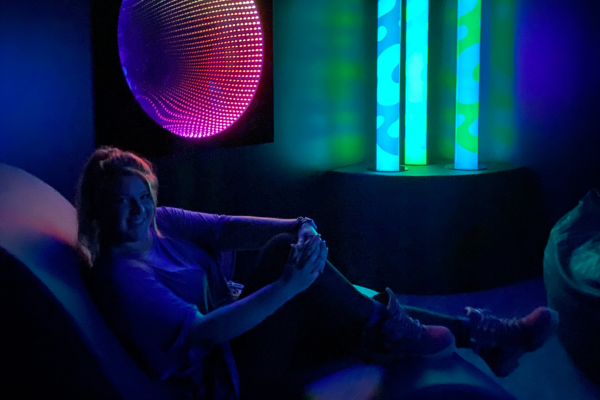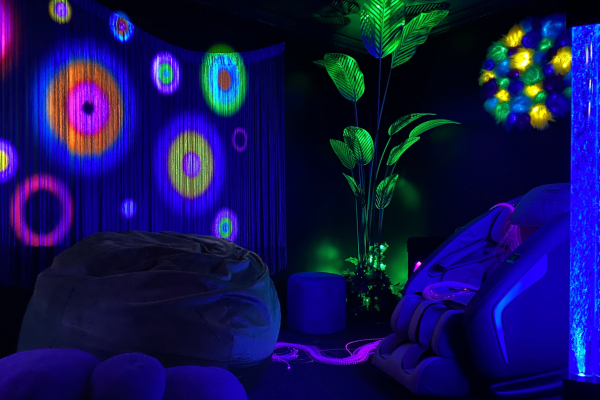If you work in healthcare, education or a forward-thinking workplace, you may have heard of a sensory space. What is it though? And why do we need a whole room devoted to our senses?
We’ll take a look at the importance of sensory processing and then explore sensory rooms and their benefits.
Table of Contents
ToggleSensory processing
Your brain is your body’s command and control centre but it bases many of its decisions on the information it receives from your senses.
Your 8 sensory systems are:
- Sight – your eyes take in rays of light and your brain interprets the signals and tells you what you’re seeing
- Taste – cells in your mouth, tongue and throat react to flavours, textures and temperatures
- Touch – important in relationships and bonding, our sense of touch enables us to feel pressure (light to firm), textures (rough, smooth, wet, dry), temperature and pain.
- Hearing – our ears receive constant sounds and our brain discerns which ones are important and which are background noise
- Smell – strongly linked to emotions and memory (and therefore capable of triggering strong reactions), your nose sends information about the odours around you to your brain
- Balance – your vestibular system in your inner ear helps you understand where your head and body are positioned and assists your coordination and stability
- Movement – your proprioceptive system in your soft tissues and joints helps you know where your body is, controls force and pressure and helps you feel grounded.
Your whole sensory system collects and organises a huge volume of information every day. It helps you unconsciously calibrate the degree to which you’re affected by sensory inputs like sights, sounds and smells.
Sometimes, it’s overwhelming, though. Loud classrooms, open plan offices, traffic noise, glaring lights, never-ending beeps and bings from electronic devices – we’ve all felt the need to sit somewhere quiet and shut out the world at the end of a busy day.
That’s where a sensory room comes in.
What is a sensory room?
Sensory rooms are purpose-designed spaces that stimulate and engage your senses to create a therapeutic benefit. Instead of feeling overwhelmed by too much sensory input, you feel soothed by just the right amount. It’s room to reset.
Our sensory spaces blend art and science to create an immersive experience in a refreshing, multisensory environment.
Are there different types of sensory rooms?
Yes, there are two main types: interactive sensory rooms and calming sensory rooms.
While they share many common characteristics, the two types of room serve different purposes.
Interactive sensory rooms are designed to teach skills as you interact with your surroundings. Users can push buttons to change colours, learn about cause and effect and practise social skills like taking turns or cooperation in an environment that engages rather than overwhelms the senses.
Calming sensory rooms, on the other hand, don’t require you to do anything. Their purpose is to help you retreat from the world for a little while so that you can find refreshment then re-engage more positively. These are the rooms we specialise in.
How do you use a calming sensory room?
All you have to do is set some time aside, walk through the door and sit down.
Once you’re in there, the room does the work. You simply sit down and let your stresses slide away for a while.
Within the room you can:
- Rest your eyes in the darkness – an instant signal that you’ve entered a different world
- Focus your attention on illuminated visual elements, light effects and slow transitions
- Slow your thoughts and heart rate in time with the slowly changing illuminations
- Listen to gentle music
- Smell the floral aromas
- Sink into comfortable seating and cushions
- Envelop yourself in a weighted blanket to stimulate your 6th sense – proprioception.
Who can benefit from a sensory room?
Anyone who’s seeking mental or emotional refreshment.
Sensory rooms were originally conceived back in the 1970s as a therapy for people with intellectual disability. As time went on, we began to see their benefits for other groups. Sensory rooms were used for people with autism, ADHD, chronic pain and mental health concerns. They’ve even been used to help new mums gain confidence with breastfeeding.
Now, though, we know that sensory rooms benefit everyone – not just people with chronic diseases or neurodiversity but anyone who feels anxious or overwhelmed and wants to reset.
Sounds good, doesn’t it?
Sensory rooms in different settings
Sensory rooms are now used in many different health, education or corporate settings.
A school could use a sensory room for children who:
- Are battling performance anxiety, social anxiety or school refusal
- Find it difficult to regulate their emotions or behaviour
- Have autism or ADHD
- Feel overwhelmed by bereavement or parental separation.
Each child’s reason for using the sensory reason is different – but they experience the same benefits, which include:
- Reduced anxiety
- Greater sense of calm
- Improved behaviour
- Better equipped to learn.
In the workplace, you might find a sensory room being used by staff who:
- Have had a day of tough meetings
- Work in demanding, client-facing roles
- Are working out how to handle a tricky situation
- Are juggling a high volume of work
- Feel under pressure, whether at work or at home
- Live with chronic conditions (1 in 3 Australians)
- Are neurodiverse.
Again, each staff member has their own reasons for using the room. But they experience the same benefits, which may include:
- Greater focus and clarity of thought
- Mental and emotional refreshment – which may enable them to manage their workload or find a way through a tricky problem
- Improved productivity
- Reduced stress and anxiety – and calmer, happier workers tend to achieve more
- Renewed energy.
How can Creative Sensory Spaces help?
We design, create and install amazing sensory rooms with bold yet harmonious, nature-inspired themes that promote mental and emotional refreshment by engaging the senses.
We know how to bring it all together. Many sensory spaces achieves far less than they could because the elements don’t work well together. As Australia’s leading experts in sensory rooms, we know how to create a design that suits your audience and your budget.





